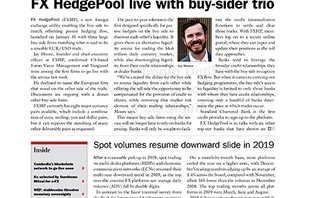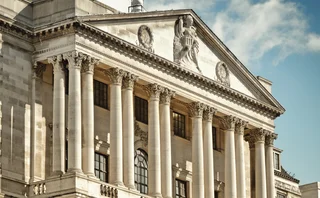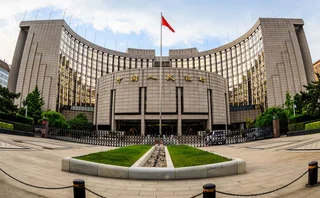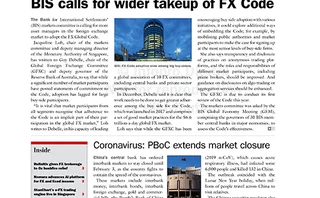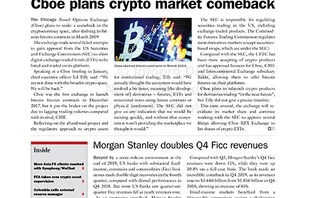
A new safe haven?
As the summer's rout in global stock markets showed, financial markets remain highly erratic. The aftershocks of the financial crisis that started four years ago have seen the debt problems that then plagued banks and corporates spreading to governments.
The US lost its Standard & Poor's AAA rating in August to AA+. But in Europe, graver dangers lurk. As Greece struggles to avoid bankruptcy, the biggest sign yet that the debt crisis is spreading to Europe's largest economies came on September 20, when S&P downgraded Italy from A+ to A. The same day, Reuters reported that Bank of China had even stopped trading FX forwards and swaps with some European banks, for fear of counterparty risk.
All of a sudden, the ‘developed' world no longer looks as safe as it once did.
Conversely, there has been a shift in how emerging markets are seen by investors desperately searching for yield. Some are even being described as ‘safe havens' - an unthinkable development in previous financial crises.
The ultimate safe havens - the Swiss franc, gold and US Treasuries - retain their cachet of course. But their appeal is much reduced. The Swiss National Bank has said it will buy "unlimited" FX to keep the Swiss franc above 1.20 per euro. US Treasuries have so far done well out of the eurozone crisis, but all dollar assets are at risk if the US announces a third round of quantitative easing. And gold, which peaked at above $1,900 per ounce on September 6, has been unusually volatile since, as investors sell on the gains.
All this means markets once considered off-limits in times of crisis are back on the radar.
"In Asia in particular, real economies are much more balanced; they lack the leverage common in G-7 economies," says Mike Moran, senior FX strategist at Standard Chartered in New York. "This is a big distinction between emerging markets and G-7 right now. Emerging markets, particularly in Asia, have the policy ammunition to address any upcoming shocks to their economies, whether those shocks are domestic or external. In G-7 economies, interest rates are already so low, and the public sector balance sheet already so bloated, there is much less flexibility to protect the economy from further shocks."
Another big difference in this, compared with previous crises, has been the emergence of China. "That has been a game-changer for the region," says Moran. "Although so much of Chinese growth is driven by demand, there is also a more stable core driving Chinese growth, and Asian economies have been diversifying, tapping into that rather than the US-centric export growth model that was the case before the Asian crisis (in 1997-98)."
One way of tapping into this trend is via a range of products now being developed to bring emerging markets FX to a wider investor base.
Indexes are seen as an efficient, effective way to get exposure to emerging markets currencies, while retaining an easy exit if things get nasty. And there is a wide range available, depending on whether a client wants to buy a simple static currency basket, or a more complex carry, momentum or volatility strategy packaged into index format.
HSBC is one of the banks that has been developing this product. In July 2010, it hired Tamas Korchmaros, now head of FX indexes in London, from rival Royal Bank of Scotland (RBS), with a remit to create an FX index business from scratch. A series of 43 separate single currency indexes (that's 42 currencies, plus gold) can be used as building blocks to create any number of composite indexes with a particular view. This so-called HSBC Smart FX Index Series (which stands for static market access return tracker) offers exposure to a number of regional themes - one that for example, takes advantage of trends in Asian, LatAm, Middle East or Bric (the group of fast-growing economies of Brazil, Russia, India and China) currencies.
This can be done on a bespoke basis. For example, one client, HSBC's own Private Bank in Geneva, wanted to create a product it could sell on to its own clients, so it asked HSBC to create an index of 20 emerging markets currencies, which the Private Bank then dynamically manages, by shifting the allocation to each currency every week (see box). Another client, a fund of funds that focuses on fixed income, wanted to create an index of currencies as a source of diversification. Because this client was more focused on bonds, an index was appealing because it looks like what they are used to in the fixed-income world. "It gives them extra comfort to engage," explains Korchmaros.
Other examples of bespoke indexes might include an FX index that replicates the country weightings of an equity or global bond index so that the underlying investment is fully hedged for currency movements. Or for bespoke corporate hedging: "Imagine a multinational that has exposures in different countries," says Korchmaros. "They could individually hedge these exposures - or we can create an index that follows their currency exposure. If the allocations change - say if they dispose of assets in some markets, we can change the index."
Investors can, of course, achieve all these ends by buying various currency products over-the-counter. But what the index format brings to the table is more transparency, instant evaluation and ease of use, developers say.
"A lot of our clients are still doing static baskets," explains Korchmaros. "If we can replace that, even with a static index where they have more transparency, or a dynamic index, where they have an element of control, that is value added.
"If you are bullish on Asia, say, you could enter into a structured note that has a maturity of five years. If, two years along the line, your view has materialised and you want to take profit, you would have to sell the note and buy a new one. With an index, you keep the same wrapper, and you change the currency underlying. It's much more efficient."
Another emerging markets index on offer is the Bric Time Select Index from RBS, which offers investors access to the currencies of that group of countries.
Launched in September 2010, the index takes its signal from the crossover of long-term and short-term moving averages, and takes a view once a month on whether to invest in the basket of four Bric currency forwards pairs (all against the US dollar). Data in the index has been back-tested to March 2000.
The index has a range of risk management features to minimise downside:
First, it only takes a position when the signal is positive - if it is bearish it disinvests.
Second, it takes only long positions. "Emerging markets tend to benefit from risk-positive environments and a stable global economy. When shocks come, the turn in sentiment and investment flows can be violent and brief," explains David Popplewell, FX structurer at the bank in London. "Timing these turns to benefit from a short emerging market position is a risky business we felt was out of place in this strategy."
Third, a volatility control mechanism increases exposure to the Bric currencies in periods of low volatility and reduces exposure as volatility increases.
The index is targeted at professional and retail private placement customers - customers that might otherwise have bought a straightforward Bric basket, explains David Popplewell, FX structurer at RBS in London.
The index format, however, makes it easier and more accessible to these clients because it comes packaged complete with oversight from RBS analysts. "These types of trades, based on momentum, carry or an economic view, require a fair amount of monitoring because they can be complex and time-sensitive. It makes sense for people not actively monitoring that market to have something that does that for them," says Popplewell.
He describes the typical customer as: "People who think there is more strength coming from the Bric group, but who are looking for a degree of risk protection and some automation, because they don't trade currencies daily themselves."
Bric appeal
Since forex is likely to be peripheral to the day-to-day activities of clients like this, indexes expressing better-known themes, such as the Bric trade, are likely to be more appealing than lesser-known trades, he says. "It's very transparent; it's very simple. It's very easy for investors to get an idea of what it is, how it works and how they expect it to behave. We designed it to make sense rationally as a trading strategy."
During this summer of unexpected volatility, the index has exited the trade repeatedly. "It has been pretty hectic for this group of currencies, this summer," says Popplewell. It disinvested from June to July. Then in late July, the signal flagged growing strength in the Bric currencies, bringing the index back in - only to get hit in the tumult in early August, when it exited again.
Navigating this minefield, the index returned 2.72% over the past year. "It has avoided the largest drops," says Popplewell.
RBS is also developing a smart carry model, which will take short positions, and a momentum-based strategy with a basket of commodity or Europe, Middle East and Africa currencies.
Other emerging markets FX indexes on offer include the Dynamic Gems (global emerging markets) series from Barclays Capital; IncomeEM, which exploits carry in emerging markets, and VXY-EM, an emerging markets volatility index, both from JP Morgan, and various other offerings from Citi, Deutsche Bank, Credit Suisse and others.
While these index developers would stop short of describing emerging markets as a bona fide safe haven, they do argue these indexes offer a good hedge for investors in times of crisis.
"Extreme events are coming round more frequently than they have in previous decades," says Popplewell at RBS. "In previous crises, there would have been more obvious safe havens to place your money in. Now, to have some investment in a group of emerging markets currencies is a sensible hedge because they may end up being a new safe haven - relative to the tumult seen in the dollar market, for example."
Belal Khan, director of foreign exchange strategy at HSBC Private Bank in Geneva, which developed its own bespoke EM index in collaboration with HSBC, adds: "If you look at many of these emerging markets currencies, 90-day volatility is less than the majors. At the same time, the yield is more attractive. Some people are calling these safe havens, but more time needs to pass. In a systemic risk event, the jury is out on whenever they will be able to maintain their low volatility."
Given these concerns, investors may want to seek out dynamic indexes, in which a rebalancing agent continually switches allocations, so they can switch to less volatile markets. "In a crisis period, these indexes can be very reactive and quickly adapted to a changing environment," says Korchmaros at HSBC.
That could prove to be crucial, if, as some people fear, the summer's volatility was just a precursor to the next big market shock.
As Luis Costa, emerging markets strategist at Citi in London sees
it: "When push comes to shove, if we are heading to another massive
disruption à la 2008, most portfolio managers would still be getting out of emerging markets and buying real safe-haven assets - Swiss francs and US Treasuries."
Case study: a bespoke index for a global private bank
One of the clients for whom HSBC has built a bespoke emerging markets index is HSBC Private Bank in Geneva.
The private bank wanted to offer a "clean, efficient, effective solution" to clients to enable them to participate in emerging markets currencies in a transparent, controlled and dynamic way. Tapping into the index business HSBC has already built in London means the Geneva-based private bank can offer such products to its own clients, based on its own views and research, and remain in control of allocation - despite not having the infrastructure to support a full index business itself.
Belal Khan, director of foreign exchange strategy at HSBC Private Bank in Geneva explains how the collaboration works.
"The FX Committee meets weekly every Tuesday morning, and by the end of the day we submit to HSBC London a spreadsheet where we input our allocation. Two days later they implement the changes.
"Clients want to know where the opportunities are in emerging markets, so we go for currencies where there is growth and strength and for fiscally responsible countries. It's not one particular strategy - but put together it's a very compelling yield story."
It needs to be a dynamic index because emerging markets are so changeable, says Khan. "You need to be able to change the portfolio to reflect changing trends and where there is likely to be relative outperformance."
Among the 20 currencies in the basket available in the index are both Chinese units - CNY, the onshore yuan, and CNH, the deliverable offshore version. "We don't necessarily allocate to both, but we want access to both so we have the option," says Khan. "There are situations where CNY could potentially offer better opportunities, so we need the option to switch."
Since its launch in June, the index has weathered a stormy summer, closing at 99.7902 on August 30, from its start at 100. "We launched just as risk aversion was growing quite rapidly," says Khan. "But it has held up very well. The calls that have turned out well are the strong calls on key currencies in China and Latin America, and also removing and reducing allocations in countries that started to turn negative."
These included currencies that suffered as a result of the eurozone weakness and political story in Europe, he explains, such as Poland and Hungary. The index also launched with a strong allocation to Mexico, but that was removed when the US slowdown soured its neighbour's prospects.
So would the bank consider launching more indexes? "This has all been very positive for us, from the working relationship with HSBC FX and Global Research in London to the ease of setting it up with our structured product team and bringing a value-added product to clients," says Khan. "We do have other currency allocation strategies we are looking to implement via an index - we run a global currency allocation strategy of 30 currencies - 10 developed and 20 emerging - that can be easily packaged into an index product." Regional strategies in Latin America and Asia are also an option, and can be customised for clients. "For example, a Brazil-based client might want an index with Brazil taken out, because they are already very long Brazil; we can easily customise that. That is what is so wonderful about an index-based product."
Only users who have a paid subscription or are part of a corporate subscription are able to print or copy content.
To access these options, along with all other subscription benefits, please contact info@fx-markets.com or view our subscription options here: https://subscriptions.fx-markets.com
You are currently unable to print this content. Please contact info@fx-markets.com to find out more.
You are currently unable to copy this content. Please contact info@fx-markets.com to find out more.
Copyright Infopro Digital Limited. All rights reserved.
As outlined in our terms and conditions, https://www.infopro-digital.com/terms-and-conditions/subscriptions/ (point 2.4), printing is limited to a single copy.
If you would like to purchase additional rights please email info@fx-markets.com
Copyright Infopro Digital Limited. All rights reserved.
You may share this content using our article tools. As outlined in our terms and conditions, https://www.infopro-digital.com/terms-and-conditions/subscriptions/ (clause 2.4), an Authorised User may only make one copy of the materials for their own personal use. You must also comply with the restrictions in clause 2.5.
If you would like to purchase additional rights please email info@fx-markets.com
More on Foreign Exchange
Average reported daily UK FX turnover hits record high
Daily turnover of $2,881bn in October 2019, up 2% from previous high of $2,821bn in April
PBoC injects 1.2 trillion yuan as markets plunge
Chinese central bank eases to support economy as coronavirus spreads; Q1 GDP growth could drop to 4%
Spot volumes on platforms resumed downward trend in 2019
But an uptick was seen in FX swaps and forwards submitted for settlement
PBoC extends market closure as coronavirus spreads rapidly
Chinese central bank extends interbank markets closure and vows to maintain ample liquidity

